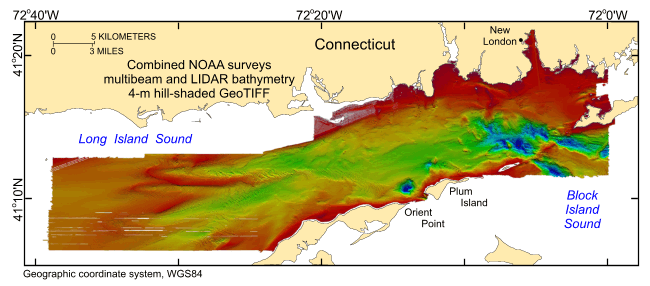| Description |
The USGS, in cooperation with NOAA and the Connecticut DEP, is producing detailed maps of the seafloor in Long Island Sound. The current phase of this cooperative research program is directed toward analyzing how bathymetric relief relates to the distribution of sedimentary environments and benthic communities. As part of this program, digital terrain models (DTMs) from bathymetry collected as part of NOAA's hydrographic charting activities are converted into ESRI raster grids and imagery (primarily of 2-m resolution), verified with bottom sampling and photography, and used to produce interpretations of seabed geology and hydrodynamic processes. Although each of the 18 completed surveys, ranging in area from 12 to 293 square kilometers, individually provides important benthic environmental information, many applications require a geographically broader perspective. For example, the usefulness of individual surveys is limited for the planning and construction of cross-Sound infrastructure, such as cables and pipelines, or for the testing of regional circulation models. To address this need, we integrated 12 multibeam and 2 LIDAR (Light Detection and Ranging) contiguous bathymetric DTMs into one dataset that covers much of eastern Long Island Sound. The new dataset is adjusted to mean lower low water, is provided in UTM Zone 18 NAD83 and geographic WGS84 projections, and is gridded to 4-m resolution. This resolution is adequate for seafloor-feature and process interpretation, but small enough to be queried and manipulated with standard GIS programs and to allow for future growth. Natural features visible in the grid include exposed bedrock outcrops, boulder lag deposits of submerged moraines, sand-wave fields, and scour depressions that reflect the strength of the oscillating tidal currents. Bedform asymmetry allows interpretations of net sediment transport. Anthropogenic artifacts visible in the bathymetric data include a dredged channel, shipwrecks, dredge spoils, mooring anchors, prop-scour depressions, buried cables, and bridge footings. Together the merged data reveal a larger, more continuous perspective of bathymetric topography than previously available, providing a fundamental framework for research and resource management activities in this major east-coast estuary. [More]
|
